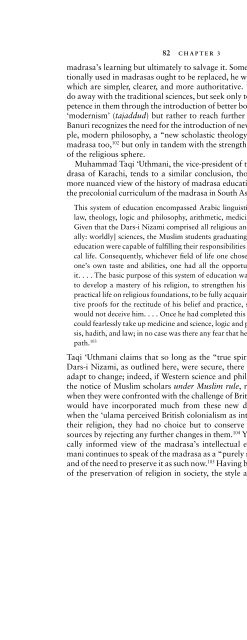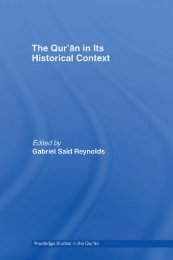Download (1 MB) - Islam and Christian-Muslim Relations: Articles ...
Download (1 MB) - Islam and Christian-Muslim Relations: Articles ...
Download (1 MB) - Islam and Christian-Muslim Relations: Articles ...
You also want an ePaper? Increase the reach of your titles
YUMPU automatically turns print PDFs into web optimized ePapers that Google loves.
82 CHAPTER 3madrasa’s learning but ultimately to salvage it. Some of the texts conventionallyused in madrasas ought to be replaced, he wrote, by earlier ones,which are simpler, clearer, <strong>and</strong> more authoritative. “We do not want todo away with the traditional sciences, but seek only to create greater competencein them through the introduction of better books. We do not want‘modernism’ (tajaddud) but rather to reach further back (taqadum).” 101Banuri recognizes the need for the introduction of new subjects (for example,modern philosophy, a “new scholastic theology,” economics) in themadrasa too, 102 but only in t<strong>and</strong>em with the strengthening <strong>and</strong> deepeningof the religious sphere.Muhammad Taqi ‘Uthmani, the vice-president of the Dar al-‘Ulum madrasaof Karachi, tends to a similar conclusion, though one based on amore nuanced view of the history of madrasa education. He observes thatthe precolonial curriculum of the madrasa in South Asia was wide-ranging:This system of education encompassed Arabic linguistics, exegesis, hadith,law, theology, logic <strong>and</strong> philosophy, arithmetic, medicine, <strong>and</strong> engineering.Given that the Dars-i Nizami comprised all religious <strong>and</strong> nonreligious [literally:worldly] sciences, the <strong>Muslim</strong> students graduating from this system ofeducation were capable of fulfilling their responsibilities in all fields of practicallife. Consequently, whichever field of life one chose in accordance withone’s own taste <strong>and</strong> abilities, one had all the opportunities to advance init....Thebasic purpose of this system of education was to enable a personto develop a mastery of his religion, to strengthen his beliefs <strong>and</strong> base hispractical life on religious foundations, to be fully acquainted with demonstrativeproofs for the rectitude of his belief <strong>and</strong> practice, so that foreign ideaswould not deceive him. ...Once he had completed this education, a studentcould fearlessly take up medicine <strong>and</strong> science, logic <strong>and</strong> philosophy, or exegesis,hadith, <strong>and</strong> law; in no case was there any fear that he would lose the rightpath. 103Taqi ‘Uthmani claims that so long as the “true spirit” <strong>and</strong> ideals of theDars-i Nizami, as outlined here, were secure, there was a willingness toadapt to change; indeed, if Western science <strong>and</strong> philosophy had come tothe notice of <strong>Muslim</strong> scholars under <strong>Muslim</strong> rule, rather than at a timewhen they were confronted with the challenge of British colonialism, theywould have incorporated much from these new disciplines. However,when the ‘ulama perceived British colonialism as intent upon destroyingtheir religion, they had no choice but to conserve their intellectual resourcesby rejecting any further changes in them. 104 Yet despite his historicallyinformed view of the madrasa’s intellectual evolution, Taqi ‘Uthmanicontinues to speak of the madrasa as a “purely religious” institution<strong>and</strong> of the need to preserve it as such now. 105 Having become the guaranteeof the preservation of religion in society, the style <strong>and</strong> substance of this



